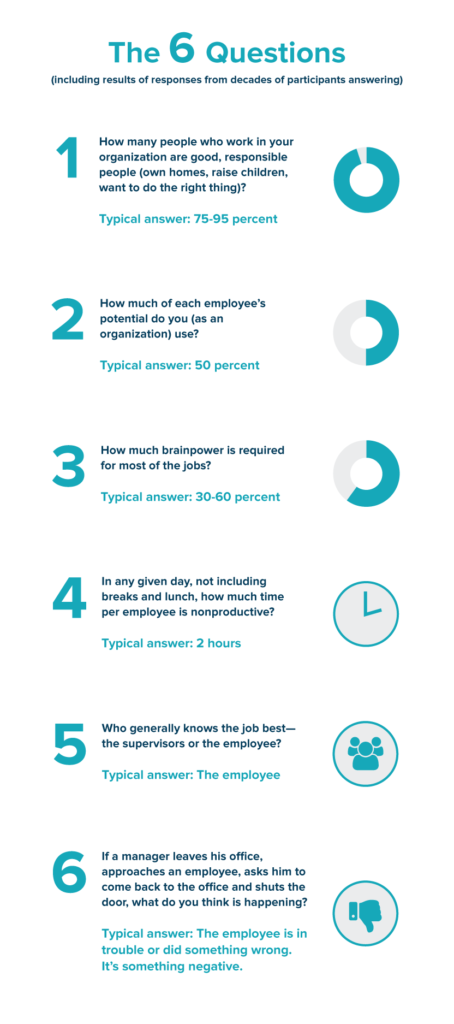
 For more than 25 years, our company has conducted high-performance workshops to help business leaders look at themselves and their teams differently. In effect, participants’ own responses drive the need for change when it comes to the state of their organizations.
For more than 25 years, our company has conducted high-performance workshops to help business leaders look at themselves and their teams differently. In effect, participants’ own responses drive the need for change when it comes to the state of their organizations.
Since 2006, their answers have been consistent: Most leaders believe that 75 to 90 percent of employees are good, responsible people. However, organizations use only half of their potential, structuring jobs that use 30 to 60 percent of employees’ brainpower. Responses consistently show that two hours of an employee’s day, on average, aren’t productive. In my time consulting, I’ve realized most companies don’t empower their people, despite stated objectives to the contrary.
If you peel back the layers of a problem, the resulting cause lies somewhere in a failure of leadership. Yet so many of our workshop participants are strong, smart, and thoughtful leaders — so what’s the problem?
It’s simple and fixable. Many of us allow experiences with bad employees (and our innate fear of failure) to dictate our practices and behaviors based on negative assumptions about the workforce. In this way, it proves we’re not naïve or easily taken advantage of. Even if leaders think they have positive assumptions, they only have to consider their locked supplies, long list of conduct rules, narrow job profiles, expectations described as “minimums,” and more that communicate lack of trust — and a belief in people’s desire to contribute and be successful.Once leaders believe most people are responsible adults who want to succeed, it changes their entire approach. The following steps ensure you begin adopting positive assumptions and finding success:
Substitute judgment for policy. Most policies are written for the small number of bad apples who’ve slipped through our hiring practices; we call them “five percenters.” Too much time is spent trying to rehabilitate or remove them. Give them as little attention as possible, and get them out quickly. Judgment is expected of leaders; let’s exercise it. Treating everyone the “same” causes unique individuals to feel like a nonvalued commodity, stripping even committed people of the positive energy that drives innovation and continuous improvement.
Demonstrate sincere belief that people are capable of far more. One company I know invested in developing its leaders and creating a culture of valued employees, but senior executives still made ninety-eight percent of the decisions. As a result, they handicapped their talented team, and one of their best managers left altogether.
We’ve found that employees encouraged to work beyond their assigned roles are more likely to exhibit deeper drive, dedication, and contribution in the workplace. Create a holistic culture of empowerment. Involve the whole team in decisions, even when you think you shouldn’t. If there’s a work slowdown, for example, invite employees to help resolve it. They know the job best and will have innovative solutions. Once true empowerment begins, you won’t need to hold meetings. When the team encounters a problem, everyone will solve it together.
 Continually check your assumptions. It’s easy to slide back into a more traditional approach to management; it’s an environment most of us know. When someone is blaming a person or department for nonperformance or a problem, ask whether all the facts are in. Operating from negative assumptions often results in blame and conflict; operating from positive assumptions means the action involves communicating and obtaining more information. This leads to a solution and eliminates the barriers that prevent team collaboration.
Continually check your assumptions. It’s easy to slide back into a more traditional approach to management; it’s an environment most of us know. When someone is blaming a person or department for nonperformance or a problem, ask whether all the facts are in. Operating from negative assumptions often results in blame and conflict; operating from positive assumptions means the action involves communicating and obtaining more information. This leads to a solution and eliminates the barriers that prevent team collaboration.
Use these steps to show your employees they’re more than another resource; they’re valued members of your organization. By doing so, you’ll have a stronger, more efficient company.
Related: CEO Voices: Building Better Leaders In 2019

0

1:00 - 5:00 pm
Over 70% of Executives Surveyed Agree: Many Strategic Planning Efforts Lack Systematic Approach Tips for Enhancing Your Strategic Planning Process
Executives expressed frustration with their current strategic planning process. Issues include:
Steve Rutan and Denise Harrison have put together an afternoon workshop that will provide the tools you need to address these concerns. They have worked with hundreds of executives to develop a systematic approach that will enable your team to make better decisions during strategic planning. Steve and Denise will walk you through exercises for prioritizing your lists and steps that will reset and reinvigorate your process. This will be a hands-on workshop that will enable you to think about your business as you use the tools that are being presented. If you are ready for a Strategic Planning tune-up, select this workshop in your registration form. The additional fee of $695 will be added to your total.

2:00 - 5:00 pm
Female leaders face the same issues all leaders do, but they often face additional challenges too. In this peer session, we will facilitate a discussion of best practices and how to overcome common barriers to help women leaders be more effective within and outside their organizations.
Limited space available.

10:30 - 5:00 pm
General’s Retreat at Hermitage Golf Course
Sponsored by UBS
General’s Retreat, built in 1986 with architect Gary Roger Baird, has been voted the “Best Golf Course in Nashville” and is a “must play” when visiting the Nashville, Tennessee area. With the beautiful setting along the Cumberland River, golfers of all capabilities will thoroughly enjoy the golf, scenery and hospitality.
The golf outing fee includes transportation to and from the hotel, greens/cart fees, use of practice facilities, and boxed lunch. The bus will leave the hotel at 10:30 am for a noon shotgun start and return to the hotel after the cocktail reception following the completion of the round.